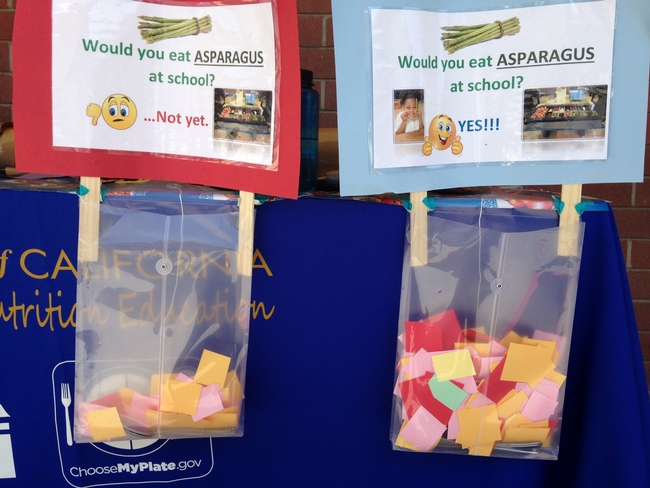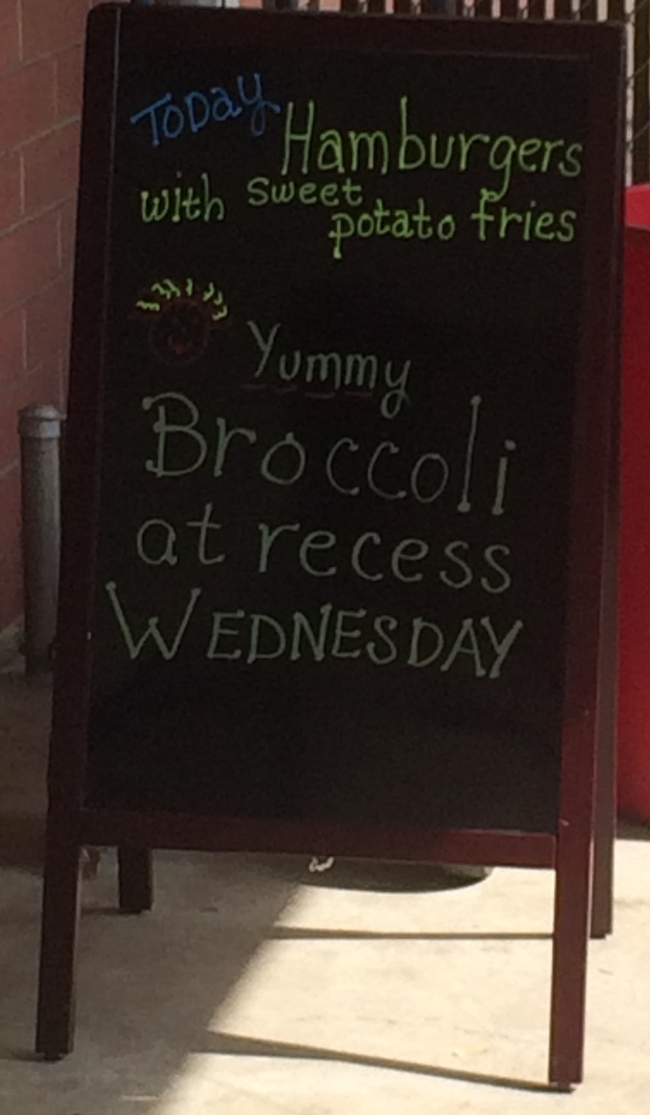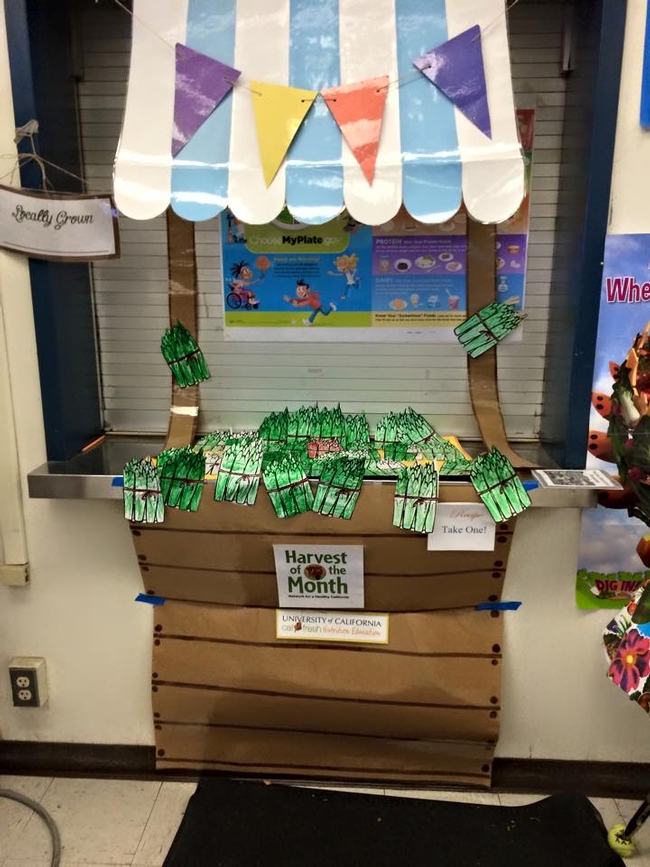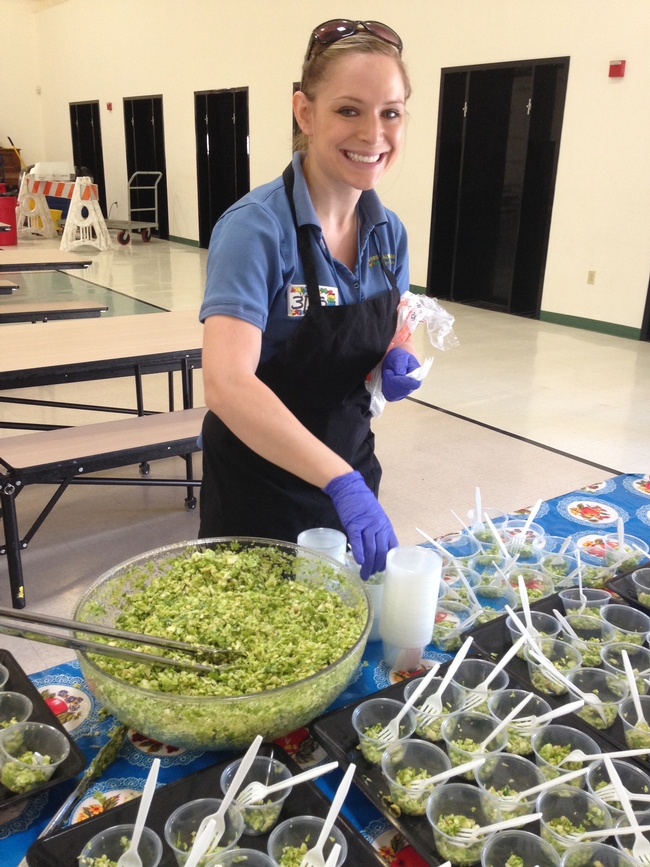
Encouraging students to eat their vegetables
Which end of an asparagus do you eat? I am not going to eat that, it's too spicy! Pink milk cartons (non-fat) are only for girls.

The collaboration included three components: monthly, school-wide seasonal produce tastings facilitated by UC CalFresh and supported by the school district; Smarter Lunchroom Movement strategies implemented by district food service staff with support from UC CalFresh; and classroom nutrition education with curricula provided by UC CalFresh and implemented by participating classroom teachers.
The monthly produce tastings were a coordinated effort between the UC CalFresh Nutrition Educators, student leaders from the Student Nutrition Advisory Council, and Cafeteria staff. The first goal was to familiarize the students in the five elementary schools with local, seasonal vegetables – and eventually get them on the school menu and on students' plates. During the months of March, April and May of 2015 more than 4,000 students at five participating schools 
Student leaders participated in all aspects of the monthly tastings, from advising on what produce items to sample, to making signs advertising the featured produce, to handing out the samples to their peers. The voting results were overwhelmingly positive with a majority of students in favor of putting Brussels sprouts, asparagus and yellow bell peppers on the school menu. As a result of these findings, and the students' enthusiasm for trying new things, food service staff are working on incorporating a Brussels sprouts salad into their regular menu.
The second component included Smarter Lunchroom Movement (SLM) strategies from the Cornell Center for Behavioral Economics. These strategies were introduced at a cafeteria manager training facilitated by UC CalFresh. At the training, district staff were introduced to SLM concepts and encouraged to identify two changes they wanted to implement in their 
Students, at first surprised seeing adults eating school meals, welcomed the nutrition educators to their tables. Staff took the opportunity to talk to the students about their food, model healthy food habits and dispel myths about their food. Myths included things like pink milk cartons (non-fat) were only for girls and school lunches are unhealthy. By the end of the school year, all participating schools had improved their scores on the Smarter Lunchroom Self-Assessment Scorecard and plans are currently being developed to provide districtwide cafeteria branding.
The third component was the in-class curricula. Classroom curricula has been the primary focus of the UC CalFresh program for many years. UC CalFresh provides “No-Prep Nutrition Education Kits” and in class food demonstrations to enrolled teachers (Educator Extenders). These Educator Extenders teach evidence-based nutrition education lessons based on the 2010 Dietary Guidelines for Americans. This year, as the collaboration with the school cafeteria developed, UC CalFresh staff rolled out the concept of Harvest of the Month mini kits and farm stands to coincide with the produce item being featured in the monthly cafeteria tastings. Educator Extenders had the 
This collaborative effort has brought about many opportunities to educate, expose and inform students and staff about local produce and how delicious it can be in their school lunches. Students who once thought that sweet yellow, green and red bell peppers were too spicy had the opportunity to sample them and see for themselves. Students who did not know which end to eat an asparagus from got to sample it and then vote on whether or not they wanted to try it again. Food service staff also got to see how excited their students were to sample new items, including Brussels sprouts, and have a voice in their school menu.
For more pictures, visit the UC CalFresh Facebook page.
An initiative to maintain and enhance healthy families and communities is part of the UC Division of Agriculture and Natural Resources Strategic Vision 2025.



healthier diet including more fruits and vegetables. An effort must be made to enable (persuade children to conform to a healthier diet. Experts in child behavior are needed
to do this successfully. My own children would not eat cooked vegetables but would eat a wide variety of raw vegetables (nutritionally better). They ate ripe fruits on
demand. They wanted sweet fruits but often categorized them as rotten. I remember years ago being given a fresh pear
from a LAUSD lunch that was so hard it took me almost a week to ripen to an edible state. Purpose of all of this is to repeat that fruits and vegetables must be edible and attractively served. School gardens in which pupils were involved in growing the vegetables motivated the pupils to
eat what they had grown.
Posted by Jack Sanders on July 15, 2015 at 11:05 AM